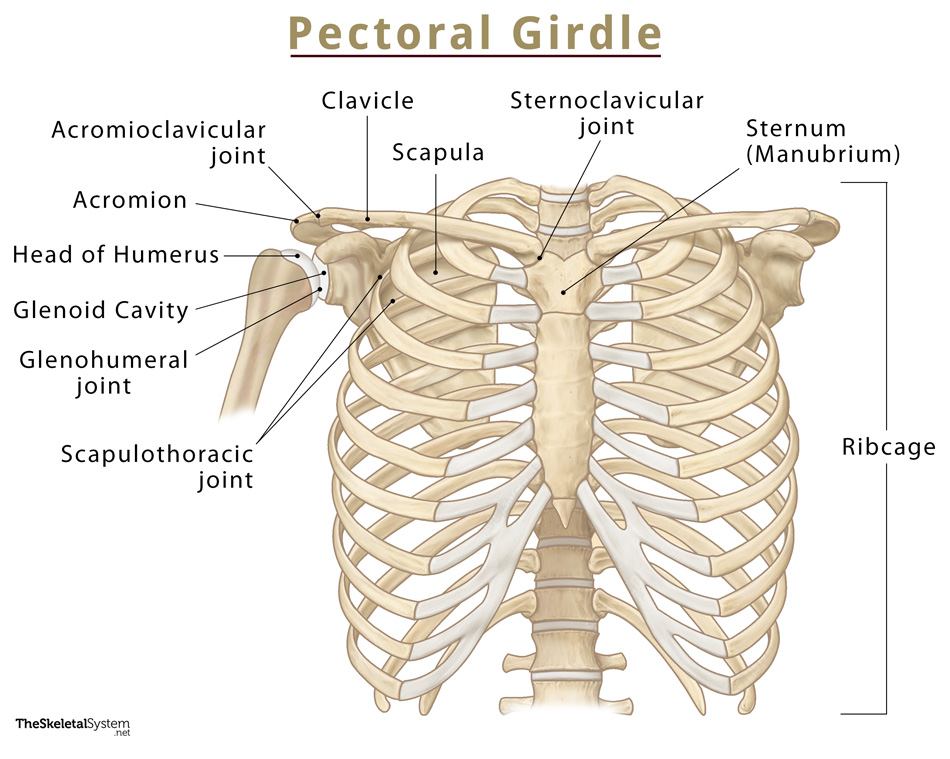Pectoral (Shoulder) Girdle
What is the Pectoral Girdle
The human skeleton has two parts — the axial skeleton, the body’s central axis, and the appendicular skeleton, which forms the limbs. The pectoral girdle, also called the shoulder girdle, is a curved bony structure that connects the appendicular skeleton to the axial skeleton at the shoulder. So, it attaches the arms to the body trunk.
Names of Bones in the Shoulder Girdle With Anatomy
The pectoral girdle consists of the shoulder bones, clavicle, and scapula that articulate to form the half-circular structure at the shoulder. There are two pectoral girdles in the human body, both capable of working independently, allowing us to use both shoulders and arms separately.
Here are the 2 bones that make up the structure:
1. Clavicle (Collarbone)
It is the long bone located horizontally at the front of the body, one on each side. The clavicles are the only bones placed horizontally in the human body. They articulate with the scapula to support the shoulder and allow the arm to rotate and perform other movements.
The clavicle is divided into the following parts through which it joins the upper arm to the axial skeleton:
- Medial end: This triangular end is also known as the sternal end because it anteriorly articulates with the sternum, the axial skeleton bone.
- Lateral end: The pointed end towards the lateral side articulates with the scapula’s acromion, forming the shoulder’s pointed tip. It is often referred to as the acromion end.
- Shaft: The middle part or the body of the bone.
2. Scapula
These are the large, triangular bones on both sides of the back. The scapula, also known as the shoulder blade, is one of the primary attachment points for several muscles that aid with arm and shoulder movements.
Apart from articulating with the clavicle at the acromion, the scapula articulates with the humerus at the glenoid cavity to form the shoulder joint.
It has three borders, named according to the direction they face:
- Medial or vertebral border
- Lateral or axillary border
- Superior border
The scapula has two angles — the inferior and the lateral angles.
Joints of the Shoulder Girdle
- Sternoclavicular (SC) Joint: The point where the clavicle meets the manubrium, the thickest and topmost part of the sternum. It is the only joint between the axial and the appendicular skeletons in the upper body. The joint lies at the center of the chest, just over the first rib.
- Scapulothoracic Joint: It is not a true synovial joint but rather a connection between the front surface of the scapula and the back of the ribcage. The ‘joint’ relies on several muscles to maintain and control the connection and allow the scapula to glide over the ribcage.
- Acromioclavicular (AC) Joint: As the name suggests, it is the joint between the acromion and the clavicle. The semicircular or V-shaped joint is the attachment point for multiple back and neck muscles.
- Glenohumeral Joint: One of the most crucial ball-and-socket joints, it is the joint between the shallow depression on the scapula, known as the glenoid cavity, and the head of the humerus. The loose joint is held in place by the rotator cuff, a solid muscular band formed by the shoulder muscles supraspinatus, infraspinatus, teres minor, and subscapularis.
Muscle Attachments
The primary muscles that attach to the pectoral girdle and act on it are the pectoralis minor, and subclavius anteriorly, and the inlevator scapulae, trapezius, and rhomboids (major and minor) in the back.
Functions
- As already mentioned, the primary function of the shoulder girdle is to attach the limbs (appendicular skeleton) to the body trunk (axial skeleton).
- Another important function is allowing the shoulder a large range of motion, especially with the mobility allowed at the scapulothoracic and sternoclavicular joints.
- Since the girdle is the main attachment point for numerous small and large neck, shoulder, back, and chest muscles, it helps in the arm and upper body movement.
FAQs
Ans. The left and right shoulder girdles form an incomplete ring because the two scapulas do not meet at the back. The space between the two scapulas allows passage to muscles that attach to the spinal column.
Ans. As discussed above, the shoulder girdle is a bony structure constituting the clavicle and scapula to connect the axial and appendicula skeletons. On the other hand, the shoulder joint is the connection between the upper arm and the shoulder, consisting of two different joints, the glenohumeral and acromioclavicular joints.
Ans. The shoulder girdle is the connection between the axial and appendicular skeletons in the upper body. In contrast, the pelvic girdle is the connection between the two in the lower body.
The pelvic girdle is formed of the three pelvic bones, the ilium, ischium, and pubis. It is stronger than the shoulder girdle as it is the primary bony structure supporting body weight and locomotion, connecting the legs to the trunk.
References
- What Is the Pectoral Girdle?: Healthline.com
- Pectoral Girdle: Bones & Functions: Study.com
- Shoulder girdle: KenHub.com
- The Pectoral Girdle: Pressbooks-dev.OER.Hawaii.edu
- Pectoral Girdle: CliffsNotes.com


